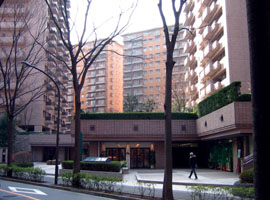Upfront: Cramming Tokyo
Back to Contents of Issue: June 2004
|
|
|
|
by Jay Johannesen |
|
 Land, or lack thereof, seems to be the explanation I have been provided when asking about all problems facing Japan. While this explanation has always struck me as over-simplistic, the fact is, land, specifically non-performing real estate projects, sits at the heart of Japan's banking crisis.
While investment in housing has been the key economic driver in the US over the past few years, Japanese households have reduced spending on housing each year since 1990 to levels far below relative household spending in other developed countries.
There is precious little that can be done to increase the archipelago's land mass, and the government, through a combination of tax reform and carefully targeted infrastructure investment, can do little to leverage real estate spending in order to help lead the country out of its economic malaise.
The Koizumi administration has declared that urban renewal (Toshi Saisei) is one of its top priorities. A massive $160 billion in new projects was proposed -- spending that, unlike most government public works projects, is concentrated on where Japanese actually live and work. For years public works spending has been at cross purposes to private sector initiative, and to the patterns of migration within Japan, building bridges to sparsely populated islands and constructing needless dams.
The beauty of urban renewal is that it can amplify private sector demand rather than simply redistribute a fixed sum, essentially creating a multiplier effect, as government spending encourages individuals and companies to make investments they otherwise would not have considered.
But urban renewal initiative is by no means universally popular among politicians. Yoshihiro Katayama, governor of Tottori Prefecture, writing in Chuo Koron, blasted the central government's policy. He believes that urban renewal means the reallocation of resources from rural prefectures to Tokyo and further concentration of people and functions in the already congested capital.
Katayama paints a bleak future for Tokyo. Citing the situation in the former industrial district of Koto Ward, where new apartment blocks have sprung up so rapidly that construction of schools and welfare facilities cannot keep pace, he argues that the central government is pursuing rampant urban development in which the only law is that of the jungle.
At first glance, Katayama seems right to oppose government spending that encourages further crowding in Tokyo. To an outsider, the concentration of 25 percent of Japan's population in Tokyo seems loony given the city's astronomical housing costs and legendary transportation gridlock. But it is a mistake to believe that the continuing migration to Tokyo is driven by infrastructure and real estate supply factors.
The situation in other countries demonstrates how in an increasingly information-driven economy, decisions on where to locate are driven by the need to nurture relationships and attract skilled workers. It was assumed that the Internet would lead to American workers telecommuting from spacious, distant suburbs, but instead, the last decade has seen economic activity increasingly cluster in urban areas such as San Francisco and Manhattan -- this in spite of cost differentials between San Francisco and say, Utah, which are greater than those between Tokyo and Toyama.
This migration pattern has been driven by non-traditional factors, particularly the life-style location preferences of individual entrepreneurs and companies' need to be in the communication loop. In Japan, where face-to-face meetings are valued far more than in the US, the need to be near key customers and partners is paramount. While Toshi Saisei is a powerful stimulus to jump-start private sector investment, to make it truly effective, the other government tools -- tax and land reform -- are essential. Japan's real estate taxes and zoning regulations keep land artificially scarce, thus land and housing prices are too high. This hurts both efficiency and demand. Property holding taxes are tiny compared to those in the US, so there is no penalty for leaving property unused.
At the same time, the maximum tax rate on selling land -- when all the capital gains taxes, land transactions taxes, and assorted other taxes are included -- can reach as high as 80 percent.
The combination of low holding taxes and high capital gains taxes creates perverse incentives. It's not surprising that within an hour's commute from central Tokyo almost half the land is either idle or nominal "farmland."
Paradoxically, the current Japanese tax code actually discourages investment and ownership of housing. Unlike in the US, mortgage interest payments are usually not tax deductible (except for some temporary deductions put in as a stimulative measure in 1999).
For years nothing has been done on land reform because reform appears to hurt two powerful lobbies: farmers and current holders of real estate. But after 11 straight years of declining land prices, even members of these groups have started to concede the need for change. There is little to lose when the market for land in some rural areas is essentially non-existent.
The combination of urban renewal and tax reform will create immediate economic stimulus and lay groundwork for continued investment. Since land was at the root of the current economic slowdown, it is only fitting that it be a key catalyst for the next upturn. @ |
|
Note: The function "email this page" is currently not supported for this page.


 Katayama calls for the central government to resume efforts to foster a decentralized society by relocating more of the political and administrative functions of the capital away from Tokyo.
Katayama calls for the central government to resume efforts to foster a decentralized society by relocating more of the political and administrative functions of the capital away from Tokyo.
 As
As 



